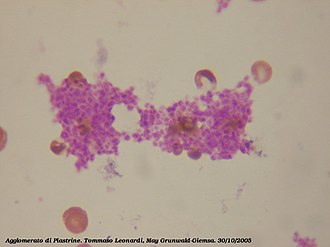Thrombocytopathy
Thrombocytopathy is a condition in which the function of plateletss fails due to an internal disorder. It can be the cause of a disorder of primary haemostasis, even if the number of platelets in the blood is normal. A distinction is made between congenital and acquired thrombocytopathies.
Thrombocytopathy:
Thrombocytopathy (details):
Congenital thrombocytopathies[edit | edit source]
Two glycoprotein complexes are important for platelets: gpIb-IX and gpIIb-IIIa, by which they bind to subendothelial structures (collagenu I and II) and to fibrinogenu. These glycoprotein complexes have a receptor function and thus participate in the process of platelet adhesion and aggregation. Their congenital defect results in congenital thrombocytopathies.
Congenital thrombocytopathies include:
- 'Bernard-Soulier syndrome (deficiency of the platelet glycoprotein complex gpIb-IX);
- 'Glanzmann's thrombocytopathy (deficiency of platelet glycoprotein complex gpIIb-IIIa). Both of these syndromes are autosomal recessive disease and cause clinically severe disorders of primary hemostasis.
- 'Von Willebrand disease' disrupts platelet function secondarily. Thus, it is not a primary platelet deficiency but a reduction in the level of Von Willebrand factor, which is essential for platelet adhesion. Without binding to Von Willebrand factor, the coagulation factor is also unstable VIII and its levels are reduced. Thus, both primary haemostasis and secondary haemostasis are impaired. Von Willebrand's disease has multiple forms, mostly disorders with autosomal dominant type of inheritance. Clinically, it is manifested by epistaxis (nosebleeds), bleeding gums, GIT and urogenital bleeding, and more intense bleeding after surgery or traumas. Laboratory findings show decreased vWF levels in plasma and decreased factor VIII levels.
- Also, the storage and degradation function of platelets can be inherently defective - this corresponds to e.g.:
- 'Heřmanský-Pudlák syndrome;
- syndrome 'Chédiak-Higashi syndrome'.
Acquired thrombocytopathies[edit | edit source]
Acquired thrombocytopathies acquired are often related to the use of drugs. For example, acetylsalicylic acid (aspirin) irreversibly inhibits cyclooxygenase required for the synthesis of thromboxaneu (an important aggregation and degranulation factor), thereby reducing the ability to heal minor bleeding by the mechanism of primary hemostasis. It then takes up to seven days after a single dose of aspirin to replace a substantial proportion of the affected platelets (without thromboxane) with new ones containing functional cyclooxygenase. Another example is penicillin, which in high doses causes impaired primary haemostasis by enveloping platelets and interfering with the substances released from their granules. Acquired thrombocytopathies may also arise in association with disorders of certain organs, such as renal failure.
Links[edit | edit source]
Related articles[edit | edit source]
References used[edit | edit source]
- NEČAS, Emanuel. Patologická fyziologie orgánových systémů 1. 1. edition. vydavatel, 2006. 0 pp. ISBN 80-246-0615-1.

